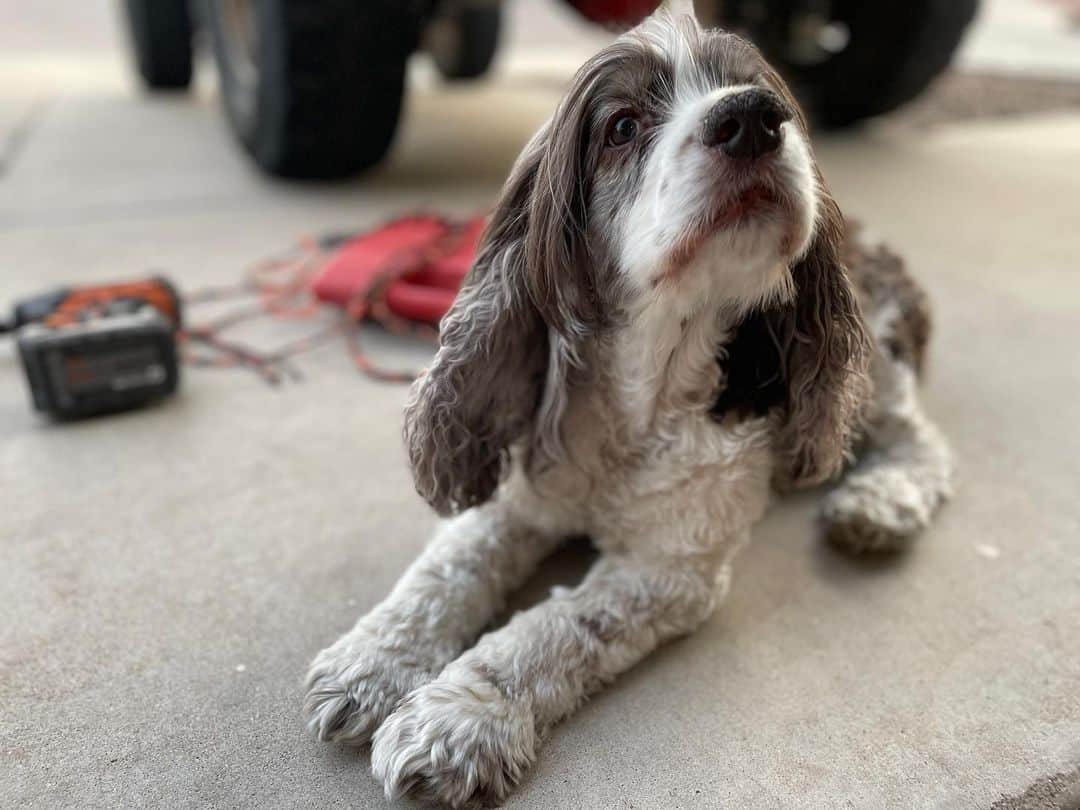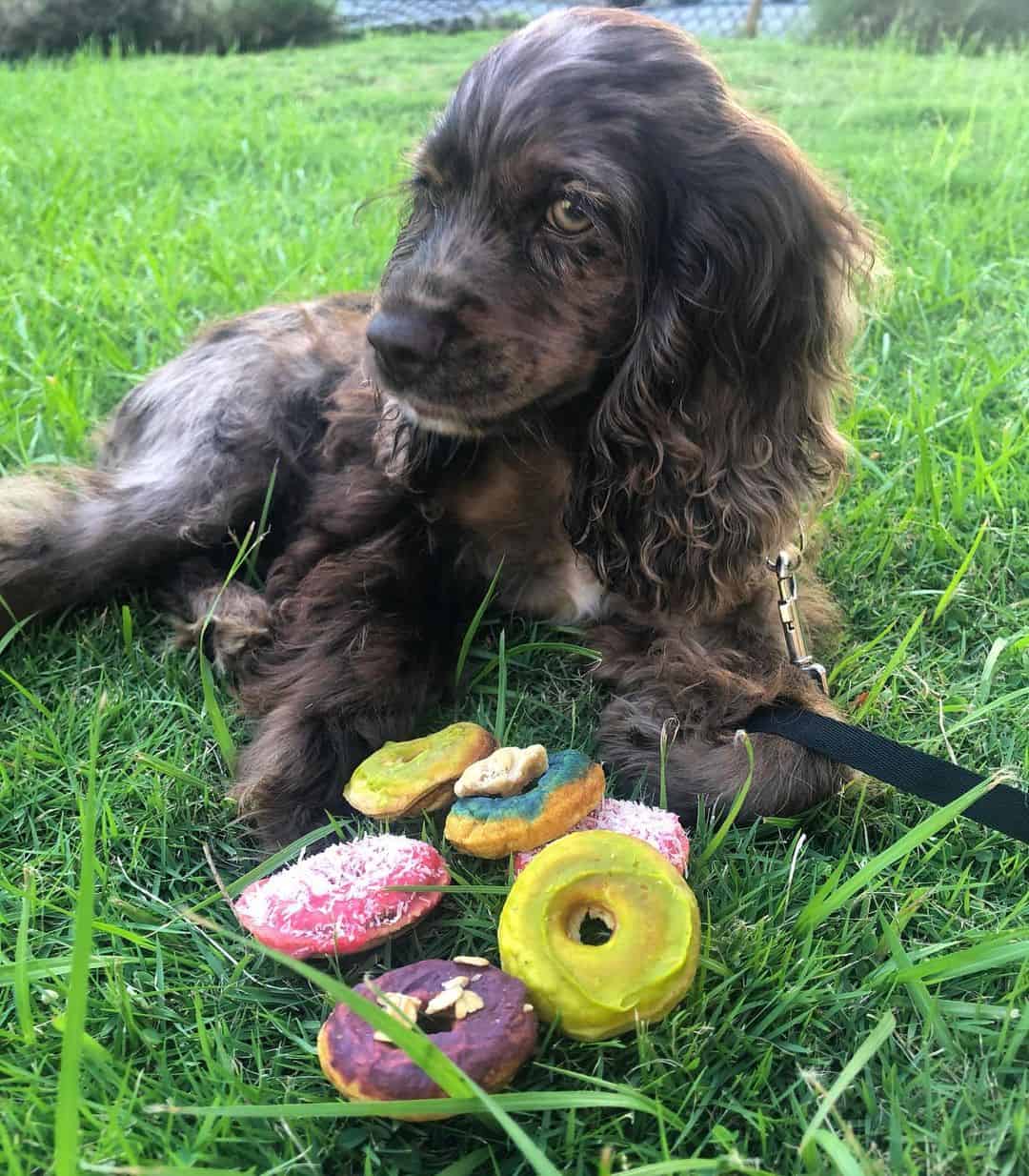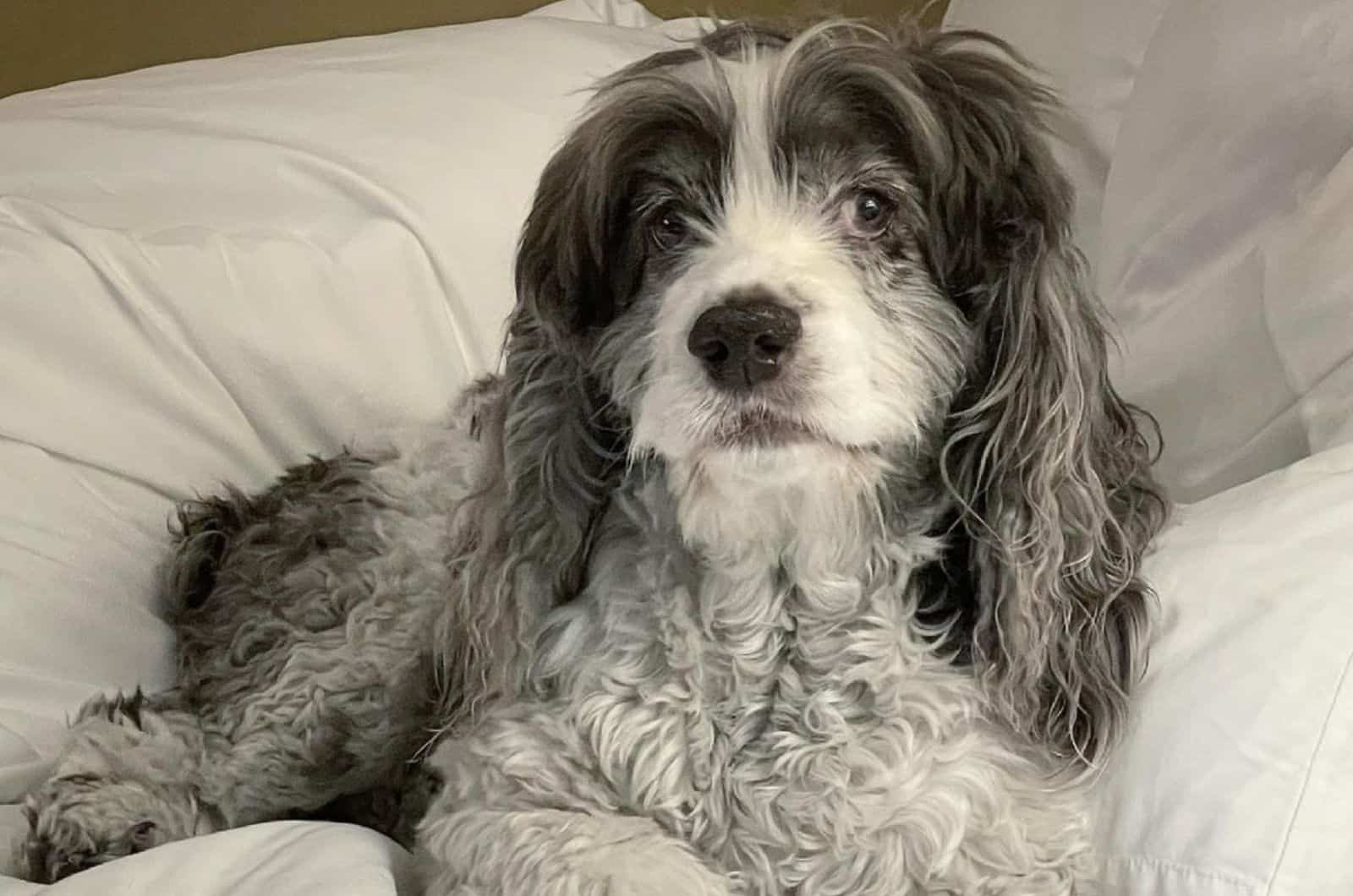There is no specific reason why you should call your Cocker Spaniel “Merlin”. I just found them to be an amazing analogy to what Merlin the wizard was to King Arthur.
Confidants and companions through your quotidian life, these dogs will follow you into any adventure you decide to embark on.
The Cocker Spaniel’s elegant appearance and loving character are known around the world. What about the merle Cocker Spaniel? What makes it different from the rest?
Merle Cocker Spaniel Report

Photo from: @babytheadventurer
You would not be wrong in thinking a merle Cocker Spaniel is just a different colored pattern of Cocker Spaniel coat. What kind of color and pattern? Well, they can differ but the most common are bluish patches on black or reddish patches on a brown base.
However, there is much more to this than color. We will find out what “merle” means or represents, how a merle Cocker Spaniel comes to life, what baggage a merle carries along and how to deal with it.
Defining The Merle Gene
A merle Cocker Spaniel genesis story is slightly more complex than just breeding. Not quite an exact science but rather playing around with genetics, developing a new color in dog breeds who do not have a track record of that particular shade is risky business.
Many refer to “merle” (M) as an incompletely dominant gene or allele rather than just a pattern of color. This gene is responsible for creating opaque patches of the main solid coat color on the dog’s body. Essentially, it dilutes the original solid coat color into lighter colored patches.
If the gene is present in both parents, the litter will assuredly be merle with a twenty five percent chance of double merle puppies. Having a merle and non-merle (m) parent makes the Cocker Spaniel puppies from the same litter merle too.
The merle gene affects not only coat color but also eye color and skin pigment. Lottery business, in the context of living things, was always a highly disputed matter. Toying with recessive genes only to produce a rare color is unethical in my opinion.
All breeds exist for a reason and have been evolving for centuries. Every breed has their own unique set of features, and dilution of the genepool introduces problems where there were none. However, the world works in a demand and supply way and dogs are in demand.
Cocker Spaniel Merle Variations

Photo from: @babytheadventurer
Merle color/pattern combinations are not “official” Cocker Spaniel outfits but that does not mean your AKC-recognized options are limited.
If you want to explore non-merle colors/patterns I recommend reading our complete Cocker Spaniel color guide.
Blue Merle Cocker Spaniel
Is it really blue? No, it is not. The diluted black color loses intensity and gives off the appearance of blue patches spread across the body. In effect, it is a grey color with bluish undertones. These Cocker Spaniels usually also have blue-grey eyes.
A blue merle generally has a differently colored nose and paws. This largely depends on how recently the merle gene was introduced into the dog’s lineage and what solid color of coat they have.
This merle pattern is incredibly rare and is not considered purebred. The American Kennel Club does not recognize merle as one of the breed standard colors.
Red Merle Cocker Spaniel
We already established that the base color for a red merle is a liver shade of brown. The dilute gene works its magic by lowering the amount of brown pigment to result in a red merle.
Again, the color is not actually red but a lighter brown with a reddish hue. The red merle has a light brown eye color with even lighter reddish patches on the paws.
The liver brown color is rarer than black in Cocker Spaniels. This means that a red merle will be quite harder to find than a blue merle. Like finding a blue merle was not hard enough…
Just like the blue merle, the red merle is not recognized by the AKC as a breed standard. In fact, most reputable breeders are campaigning against breeding merle genes into their respective breeds.
Double Merle
What makes the double merle double? It is the fact that both parents have the merle gene. One in four puppies from a double merle litter actually becomes a double merle. The rest will be merle offspring.
Double merles do not just have double the pattern (whatever that means). Instead, the dilute is so intense that the Cocker Spaniel is either:
– not pigmented at all (completely white coat), or
– has slightly visible patches of a base color over white.
In some breeds like the Australian shepherd (Collie – think Lassie!), it is very difficult to determine if the dog is a double merle or not. That is due to their standard coat variations, including white.
With Cocker Spaniels, it is rather easy to find out since there are no pure white coat Spaniels. A double merle Cocker Spaniel will have very lightly colored brown, green or blue eyes. They can even have heterochromia (differently colored eyes).
The double merle is the rarest of the three merle variations and is considered a bad breeding practice due to the health risks it carries.
The Process Of Breeding A Merle Cocker Spaniel

Photo from: @azyrapr
So, how do breeders accomplish this task of producing Cocker Spaniels with the merle gene? The practice spans back quite a while and there is no concrete scientific proof of how the merle gene even became part of the breed.
Scientists theorize that the dilute has been present in canines since their first pre-domesticated wolf ancestors. When or from where the gene was “injected” into the Cocker Spaniel lineage is unknown.
Information generally points to breeding the Spaniel with other breeds more closely related to their ancestors, like the Australian Shepherd dog, which is deemed to be among the first to possess the merle gene. Crosses between Cocker Spaniels and Collies are called Shelties.
Nowadays, merle Cocker Spaniels have a more precisely defined lineage as a result of selective breeding. Breeding non-merles with merle Cocker Spaniels keeps this questionable practice in life.
This phenomenon is not exclusive to this breed but is present in breeds popular for their merle color like the Dachshund or Great Dane.
Why The Cocker Spaniel Community Disputes The Merle
We have already touched on the topic of unethical breeding and health problems stemming from breeding merle Cocker Spaniels so let us just expand on that.
If you are a dog owner, and especially if you had a dog suffering from a certain condition, you will know how unsettling watching them struggle is. Constant vet visits, lowered quality of life, treatment and maybe even surgery, can take a toll on both your dog and you.
Most of us who, above all, want their dog to be healthy and happy, most likely do not agree with the merle selective breeding practice.
Cocker Spaniels have been great companions, flushers and service dogs for humans. Why is it more important to have a dog with a “unique” coat color than one without any health issues?
That exact question can be easily answered by turning our heads toward ourselves. We humans like to think of a dog’s appearance as a token of individuality. Being one-of-a-kind is high on our list of priorities while a dog’s priority is having a good, fulfilling life with their owner.
The American Spaniel Club On Breeder Practices
A word of authority on the merle Cocker Spaniel comes from the American Spaniel Club too. This Spaniel Club was founded in 1881 and is among the oldest Cocker Spaniel clubs in the US.
Their goal is to instill ethical breeding practices and help the breed stay within the margins of tradition. Through projects, scientific data and information, and education, the ASC encourages both owners and breeders to adhere to certain rules for the preservation of the breed.
The ASC also seeks to lower the number of abandoned Cocker Spaniels through their American Spaniel Club Foundation. All of the donations to the ASC Foundation are spent on researching Cocker Spaniel health, rescues and education.
Both the AKC and the ASC, along with certified breeders, strongly oppose and combat breeding non-merle Cocker Spaniels with merles. The places where the dreaded double-merle breeding occurs most commonly are puppy mills.
This cannot be prevented without the help of people who seek out non-certified and backyard breeders.
These organizations, and all those who love and appreciate dogs, need to keep fighting the spread of such desire for genetically manipulated breed specimens by educating those who are not aware of the issues at hand.
Digging Deeper Into Merle Health Issues
I have been talking about health problems, genetics and breeding practices without ever mentioning explicit conditions that affect breeds with the merle gene.
So, let us go over the things that can go wrong if you decide to get a merle Cocker Spaniel.
Blindness And Deafness
Studies confirmed that merle dogs have a rather high incidence of hearing loss and eye abnormalities.
Hearing problems are among the most common, especially in double merles. Some puppies are born partially or completely deaf. If the hearing loss occurs some time after birth, it is, most likely, not because of the merle gene.
If a merle Cocker Spaniel puppy exhibits traits such as a double merle coat (all white or barely distinguishable coloration on white base coat) and blue, green or light brown eyes, there is a high chance that it has eye problems.
The most common eye condition in a merle Cocker Spaniel is Merle Ocular Dysgenesis (MOD). This is, obviously, an inherited defect carried by the merle gene. Cataracts are also more probable on a dog that exhibits a “merle color”.
Of course, a merle or even double merle dog can have perfectly good hearing and eyes, but that is seldom the case with merle breeding.
Skin Conditions
Since the skin is the most pigmented organ on a dog’s body, the merle gene affects its properties the most. Skin cancer and general sensitivity to allergens, heat, cold etc. are not that common in merle Cocker Spaniels but double merles have higher chances of developing these.
Breeders And Merle Cocker Spaniel Price

Photo from: @babytheadventurer
Plenty has been said about breeders until now. Choosing the right breeder is, likely, the most difficult task when getting a merle Cocker Spaniel. There are lots of them and a significant number practice unethical breeding.
Unethical breeders, in most cases, do not provide you with a health guarantee when you first get your puppy. You should always ask about whether a breeder issues health guarantees on parents and puppies.
In case you live in Ontario or simply want a good breeder regardless of location, have a read on the seven best Cocker Spaniel breeders in the States.
Cocker Spaniels are rather pricey. The average is $500 – $1500. If you are going for a merle Cocker Spaniel or a reputable Spaniel lineage then expect to pay even upwards of $3000. The cost largely depends on the breeder and can vary significantly.
Take a look at our detailed Cocker Spaniel pricing piece for more information.
Is A Roan Cocker Better Than A Merle?
What on earth is a Roan Cocker? It is a healthy “version” of a fashionable Cocker Spaniel. The Roan pattern does not have any connection with the merle gene. Some can find the two patterns too similar to distinguish but the differences can be easily spotted.
You want to know how? Well, the Roan Cocker’s colors are NOT diluted like the merle’s. It is simply a matter of a multi-colored coat. In fact, the Roan Cocker is a subtype of the parti-color Cocker Spaniel.
Wait, what is a parti-color? The “parti” is short for particular and means that two particular color combinations can occur on the coat.
According to the AKC, for a Cocker Spaniel to be parti-color, one of the colors must be white while the other can be black, red, cream or brown.
Keep in mind that any of these combinations have to be accompanied by tan points in the same part of the body where the black Spaniel has it.
Can I Get A Roan Cocker Spaniel In Different Colors?
Short answer: YES! Roan is simply a well separated multi-color pattern. Black and white are the most common roans and the red and brown can come in different shades of the color, along with white of course.
More good news. The colors on a roan Cocker Spaniel do not fade! They stay rich and punchy in their old age too.
American Cocker Spaniel or English Cocker Spaniel

Photo from: @azyrapr
These two Cocker Spaniel types are a product of delineating breeding practices between the United Kingdom and American breeders.
Historically, the English Cocker Spaniel arrived on American soil back in the seventeenth century with the Pilgrims. The breed was used for work and companionship and grew in popularity in North America by the nineteenth century.
The AKC recognizes the two breeds as separate since they have obvious physical differences. Let us briefly take a look. If you are interested in an in-depth comparison make sure to check our full article on English Vs. American Cocker Spaniel!
Main Physical Differences
First of all, the head shape of the American Cocker Spaniel is more rounded. This includes the eye shape. The body is of similar proportions but the English Cocker Spaniel has a slightly bigger frame.
The muzzle of the American Cocker is shorter in length and the forehead bones are more accentuated.
Coats are slightly different too, primarily in the available shades. Red English Cocker Spaniels are rarer than their American counterparts and the roan cocker is uncommon in the American breed lineage.
Would you like to know more about shedding potential? Get your answer on everything you need to know about Cocker Spaniel shedding.
While we are on the topic of coat and shedding, you are probably wondering about the hypoallergenic properties of the Cocker Spaniel. We love to debunk myths so make sure to check out whether Cocker Spaniels ARE hypoallergenic or not.
In general, there are fewer coat color choices for the American than the English Cocker Spaniel. Fun fact: the American Cocker Spaniel is the AKC’s smallest acknowledged sporting dog.
Do They Act The Same?
Character-wise, both breeds have a similar demeanor. The English Cocker Spaniel is just a touch less obedient than its American cousin.
In terms of energy levels, both are equal. The American Cocker Spaniel, nicknamed the Merry Cocker, gives off a happier aura and is considered to be among the best family dogs.
That aura, though, is channeled through their inner voice box. How much do they bark? Depends on how lucky you are with puppy selection.
Living with other dogs or pets can be difficult if socialization is not done properly and on time. Both breeds have a knack for nibbling too, if not obedience trained.
English Cocker Spaniels prefer outdoors living, unlike the more “urbanized” American Cocker.
Life Expectancy
American and English Cocker Spaniels have a lowerish lifespan. At least compared to breeds of comparable size.
On average, they live ten to eleven years of age. However, the English Cocker Spaniel can reach the upper limit, while the American cousin’s age seldom goes into the “extra year”.
A Third Challenger Approaches: The Cavalier King Charles Spaniel

What is the deal with this fellow? Who is he and where did it come from?
The King Charles is a toy breed version of the English Cocker Spaniel. Clearly, the size was accomplished by selective breeding.
Only the smallest English Cocker Spaniels were selected from different litters and then bred to polish the gene into a fully-fledged lineage.
The breed was named after King Charles (duh) but only because he was so obsessed with breeding this toy-sized Cocker Spaniel. His contemporaries considered this a travesty since his interest in Britain was not even nearly as big as in breeding the dog.
Kingly Looks?
Cavalierish looks I would say. They grow up to twelve inches but an inch shorter is within the norm too. Anything over eighteen pounds is considered overweight.
The expansive gaze of a King Charles Spaniel perfectly compliments the round eyes. The head is flatter than the original Cocker Spaniel’s and the ears’ root stands slightly higher than the Cocker Spaniel’s.
The King Charles has an average coat length. Not quite as long as the Cocker Spaniel’s but not far off either. The coat quality is very smooth with a wavy shape to top it off.
Color options are not as abundant as in the Cocker Spaniel but that is a trademark of the breed – make what you have perfect! For those curious about all the options here are 10 Royal Editions of the Cavalier outfit.
Shedding is not a problem and the King Charles does not have to be groomed too often. One feature that makes it seem a bit sloppy is the drooling. No, it is nothing exaggerated but a drop or two a day keeps the dry couch away.
Tableside Manners
Rejoice couch potatoes of the world. The King Charles will synchronize with you in a manner you have never seen in a dog before.
Whether you lead an active, outdoorsy and exercise-driven life or you enjoy watching tv, playing games or hanging out at home, the King Charles will adapt equally well to both.
They are ok with basically anything: guests, kids, other animals and the sorts. They are very trainable but if you get a lazy Charles, it is not your fault.
Do not mistake this dog for a bulldog. They require certain physical activity like a long walk or half an hour of playtime before dinner or lunch.
Even though they do not fall into the small dog category, they love company. Separation anxiety can happen if left alone for prolonged periods of time. Luckily, because they are adaptable, if your workplace allows dogs – bring it along.
Life Expectancy And Where To Find Them
The King Charles beats the other two Cocker Spaniels in this department. For a toy-size dog, a lifespan of nine to fourteen years is incredibly good.
I guess King Charles II managed to do something good during his reign after all. And we left a whole article on their lifespan.
Of course you want to see where to get one. They just have that way of pulling you in. I will point you in the right direction: The 6 Best Cavalier King Charles Spaniel Breeders In The U.S.
To Wrap Things Up
There was a lot to digest in this Merle Cocker Spaniel diary entry. We learned about merle genes and why breeding dogs with “the merle” is a controversial topic. The information on health issues surrounding the genetics business should be enough to make your mind up on the topic.
You saw some alternative options that do not have the merle curse on them. Choosing a breed that has fewer health problems is better than going for a dog with predisposition for a genetic condition simply because of color.
If a merle Cocker Spaniel is still your choice, make sure to explore all breeder options. Always ask for health guarantees and avoid suspiciously low prices of Cocker Spaniel puppies.
Good luck in your dog acquisition endeavors!
